DDT was manufactured for public use and entire towns were sprayed almost overnight. The idea was that mankind could improve on nature. Paul Muller won the Nobel Prize for inventing DDT. An agricultural program was initiated to eradicate the fire ant and showcase the power of chemical pesticides. Over 20 million acres of land in the south was doused with DDT. Although this did kill the fire ants, it also killed most other wildlife in the area. The chemical industry denied any connection between the crop dusting and the environmental effects.
The Widespread Use of DDT
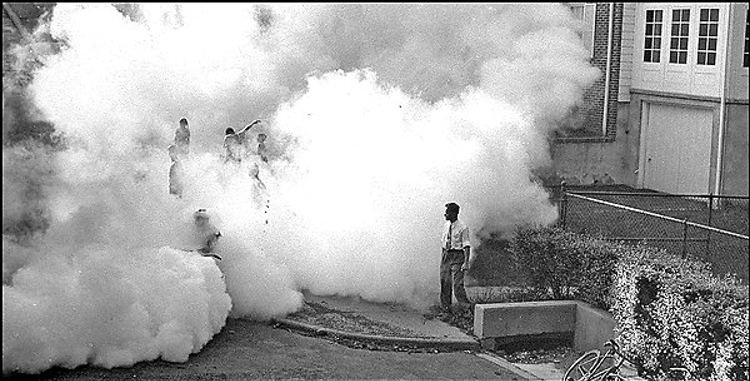
DDT being sprayed over a crowd of people.
WordPress.com
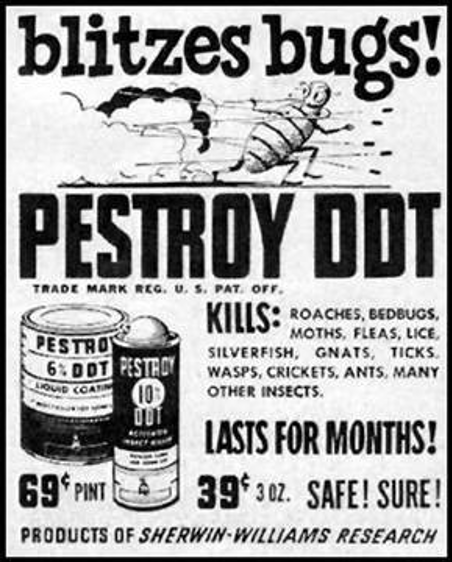
Jones, Thomas C, Golabz
In 1959 was the cranberry scare, where pesticides sprayed on the cranberry crop got into the nation’s food supply. This worried the public because research was showing that pesticide exposure could be very dangerous. The government and chemical companies swooped in to quiet the uproar, with people like Richard Nixon and John F. Kennedy eating the supposedly tainted cranberries. Even so, people could still buy thousands of different products with DDT, everything from the spray itself to DDT soaked wallpaper.
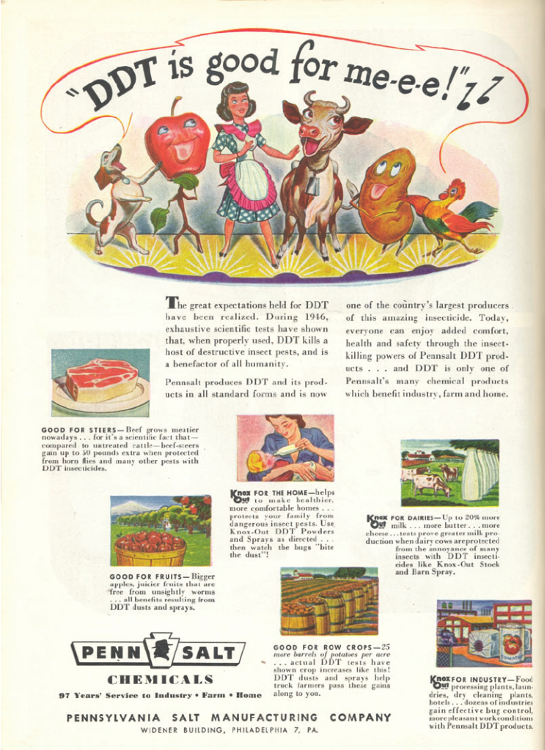
An example of the DDT propaganda, this one published in a children's and family magazine.
Organic Consumers Association

Science History Institute Digital Collections
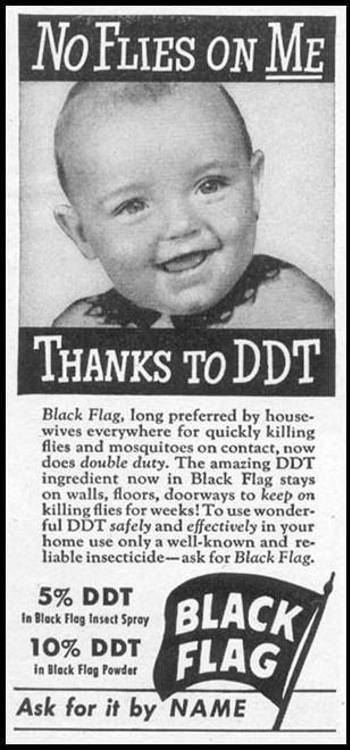
Anderson, Seth, Flickr
Silent Spring: Silent No Longer
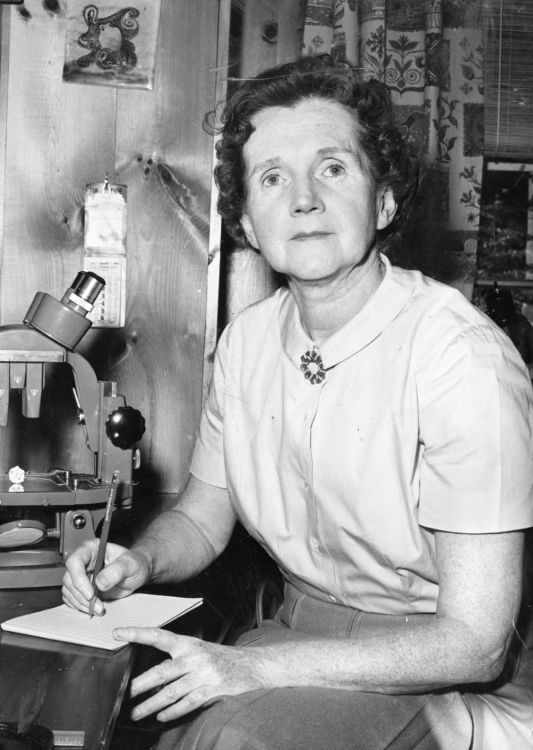
Theresa, Old Pittsburgh Photos and Stories | The Digs.
Carson was wary of accepting the safety of chemicals. Everything Rachel loved in nature was severely threatened by synthetic pesticides. She took it as her mission to show the world how perfect the natural systems were, and how easily the hand of man can destroy them. In 1958, Carson began the book that would become Silent Spring. By then, she was certain that synthetic pesticides were to blame for this sudden plague. Her certainty was strengthened when a study was published showing that pesticides caused blood cancer. The cranberry scare further proved her point. Halfway through her book, Carson found out that she had breast cancer. In fear of her opponents claiming that she wrote the book on the “unfounded” claim that pesticides cause cancer, she kept the news quiet. In January 1961, Carson finished radiation treatment. She submitted the manuscript almost four years after she began. In 1962, Silent Spring was finally published.
"There was once a town in the heart of America where all life seemed to live in harmony with its surroundings. The town lay in the midst of a checkerboard of prosperous farms, with fields of grain and hillsides of orchards where, in spring, white clouds of bloom drifted above the green fields. In autumn, oak and maple and birch set up a blaze of color that flamed and flickered across a backdrop of pines.
Then foxes barked in the hills and deer silently crossed the fields, half hidden in the mists of the fall mornings. Along the roads, laurel, viburnum and alder, great ferns and wildflowers delighted the traveler's eye through much of the year. Even in winter the roadsides were places of beauty, where countless birds came to feed on the berries and on the seed heads of the dried weeds rising above the snow.
The countryside was, in fact, famous for the abundance and variety of its bird life, and when the flood of migrants was pouring through in spring and fall people traveled from great distances to observe them. Others came to fish the streams, fish flowed clear and cold out of the hills and contained shady pools where trout lay. So it had been from the days many years ago when the first settlers raised their houses, sank their wells, and built their barns.
Then a strange blight crept over the area and everything began to change. Some evil spell had settled on the community: mysterious maladies swept the flocks of chickens; the cattle and sheep sickened and died. Everywhere was a shadow of death. The farmers spoke of much illness among their families. In the town the doctors had become more and more puzzled by new kinds of sickness appearing among their patients. There had been several sudden and unexplained deaths, not only among adults but even among children, who would be stricken suddenly while at play and die within a few hours.
There was a strange stillness. The birds, for example—where had they gone? Many people spoke of them, puzzled and disturbed. The feeding stations in the backyards were deserted. The few birds seen anywhere were moribund; they trembled violently and could not fly. It was spring without voices. On the mornings that had once throbbed with the dawn chorus of robins, catbirds, doves, jays, wrens, and scores of other bird voices there was now no sound; only silence lay over the fields and woods and marsh.
On the farms the hens brooded, but no chicks hatched. The farmers complained that they were unable to raise any pigs—the litters were small and the young survived only a few days. The apple trees were coming into bloom but no bees droned among the blossoms, so there was no pollination and there would be no fruit.
The roadsides, once so attractive, were now lined with browned and withered vegetation as though swept by fire. These, too, were silent, deserted by all living things. Even the streams were now lifeless. Anglers no longer visited them, for all the fish had died. In the gutters under the eaves and between the shingles of the roofs, a white granular powder still showed a few patches; some weeks before it had fallen like snow upon the roofs and the lawns, the fields and streams.
No witchcraft, no enemy action had silenced the birth of new life in this stricken world. The people had done it themselves."
An excerpt from the famous first page of Silent Spring.
Rachel Carson in Silent Spring

The original cover of Rachel Carson's Silent Spring.
National Museum of American History
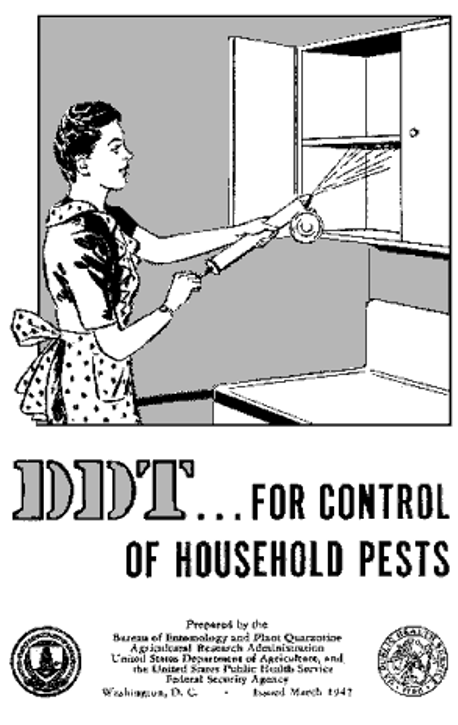
An ad for a household version of DDT
Food Exposed